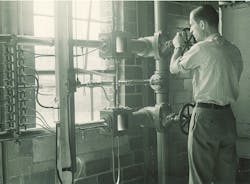The Old Timer of Royal Oak, Mich., was a regular contributor to H&P years before we ever even heard of the internet. But most of his advice is just as ueful — and interesting — today.
So rather than leave his wisdom printed on pages archived in our storage room, I pulled out issues from the late 1980s and early 1990s and will reproduce relevant entries in this blog. Here is my fifth entry, which was originally published in the October 1987 issue:
How fast can you push oil?
Most of the action in a hydraulic system is out of sight — a little mysterious. You know oil is flowing inside the piping because you see the actuator move, but out on the production floor you don’t have the instrumentation or any reason to measure the actual flow. You might just take a wild guess. If, however, you had the time and plenty of precision equipment — such as high-speed cameras, multigraph recorders, microsecond timers, and all sorts of position, velocity, and travel pickups — you could quantify your answer, and it might be eye opening.We had all that equipment for a project to optimize performance of a huge die casting machine. The machine’s 6-ft long, 8-in. bore shot cylinder was fed by 6-in lines from a 200-gal accumulator. We recorded average piston velocities at more than 1200 ft/min. That translated into 2400 ft/min oil velocity in the lines. And because the full stroke involved acceleration and deceleration, we calculated oil flow at maximum piston speed to be 3000 ft/min.
Was that about as fast as oil could flow? 3000 ft/min (50 ft/sec) — somewhere around 55 mph?
The driving medium in this application was pressurized nitrogen in the accumulator; and gas can flow through an orifice at about 53% of the speed of sound — around 1100 ft/sec. That gave us a theoretical velocity ten times faster than what we were getting. Could we use greater cylinder velocity to produce denser castings? Let’s try for 100 ft/sec and see.
We shortened lines to move the accumulator next to the cylinder; eliminated as many elbows and fittings as possible; installed an 8-in. triggering valve; elevated system pressure; and let her rip. Our oil flow rate approached 100 ft/sec. The result: the castings got worse! Entrained air in the dies had no time to escape, and the bubble-riddled castings were too porous to use.
The project was abandoned in favor of another concept; but while it lasted, it was fun to stretch what hydraulics could do when you had the time and budget.


